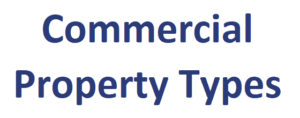Commercial Property Types
The main property types that can be used to create a low-risk portfolio include office space, industrial/warehouse, retail, and multi-family. Some investors may also want to include hospitality properties (hotels and motels) even though these kinds of real estate properties are considered riskier. The reason is that no leases are involved in hospitality properties. Moreover, the performance of these kinds of properties is highly correlated with the business cycle. Different commercial property types may have considerably different characteristics, which we will discuss in more detail below.
It is important to know that with all property types, location is the most critical determinant in determining property value. On this page, we discuss office, industrial, retail and multifamily real estate property characteristics.
Office real estate
Demand for office real estate depends heavily on job growth, especially in industries that are heavy users of office space like the financial services sector. The average length of office leases varies globally.
There are two kinds of leases. In a gross lease, the owner is responsible for the operating expenses. In a net lease, the tenant is responsible. In a net lease, the tenant therefore bears the risk that, if the actual operating expenses are greater than expected, the rental price will be higher. As a result, rent under a net lease is lower than a gross lease. This compensates the tenant for bearing this risk.
Some leases combine features from both gross and net leases. For example, the owner of the property might pay the operating expenses in the first year of the lease. Thereafter, any increase in the expenses is passed through to the tenant. In a multi-tenant building, the expenses are usually shared between the owners based on square footage owned.
Industrial real estate
Demand for industrial real estate is heavily dependent on the business cycle. Demand is also affected by import/export activity of the economy. Industrial real estate typically uses net leases.
Retail real estate
Demand for retail real estate is heavily dependent on consumers’ willingness to spend money. This consumer spending is affected by the overall economy, job growth, population growth, and savings rates. Retail lease terms vary by the quality of the property as well as the size and the importance of the tenant. For example, an important tenant may receive favourable lease terms to attract them to the property. In turn, this so-called anchor tenant may draw other tenants to the property. Take the example of a shopping mall with a large grocery store.
Retail tenants are often required to pay additional rent once sales reach a certain level. This unique feature is known as a percentage lease or percentage rent.
Multi-family real estate
Demand for multi-family real estate depends mainly on population growth, especially in the age demographic that typically rents apartments. This age demographic can vary by country and over time. It may also vary by type of property, and locale. Demand is also affected by the cost of buying versus the cost of renting, which is measured by the ratio of home prices to rents. As home prices go up, there will be a shift towards renting. An increase in interest rates may also make buying more expensive, and vice-versa.
Summary
We discussed four types of commercial real estate that investors can consider when investing in real estate.

